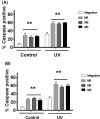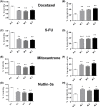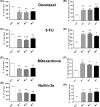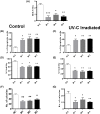Long noncoding RNA MIAT regulates apoptosis and the apoptotic response to chemotherapeutic agents in breast cancer cell lines
- PMID: 29914974
- PMCID: PMC6435567
- DOI: 10.1042/BSR20180704
Long noncoding RNA MIAT regulates apoptosis and the apoptotic response to chemotherapeutic agents in breast cancer cell lines
Abstract
The long noncoding RNA myocardial infarction associated transcript (MIAT) is involved in a number of diseases, including myocardial infarction and diabetic retinopathy. Emerging evidence suggests that MIAT expression levels are increased in different type of cancers, including breast cancer. In the present study, we further evaluated the role of MIAT in breast cancer and investigated the consequences of its silencing on breast cancer response to chemotherapeutic agents. Expression levels of MIAT mRNA in breast cancer were determined using TissueScan™ Breast Cancer cDNA Arrays. Breast cancer cell lines were transfected with MIAT specific siRNAs, with silencing confirmed using RT-qPCR and the effects on breast cancer cell survival and response to different apoptotic stimuli determined. MIAT transcript levels were significantly elevated in breast cancer samples. Such increase was specific to the early stages of the disease, ER, PR +ve, HER -ve, and triple negative breast cancer samples. Silencing of MIAT induced growth arrest and increased basal apoptosis. Reduced levels of MIAT augmented the apoptotic response of breast cancer cells to a wide range of apoptotic stimuli. Our results also showed that MIAT down-regulation was associated with a decrease in OCT4 mRNA, suggesting the existence of a MIAT/OCT4 regulatory loop, similar to that observed in malignant mature B cells. Taken together with the recent demonstration of oncogene characteristics, our observations suggest that MIAT plays an important role in breast tumorigenesis. Strategies to decrease MIAT expression levels may improve sensitivity to therapy in breast cancer by enhancing the apoptotic responses to conventional chemotherapies.
Keywords: Apoptosis; Breast; Cancer; Chemotherapy; MIAT; OCT4.
© 2018 The Author(s).
Conflict of interest statement
The authors declare that there are no competing interests associated with the manuscript.
Figures








Similar articles
-
Long non-coding RNA MIAT is estrogen-responsive and promotes estrogen-induced proliferation in ER-positive breast cancer cells.Biochem Biophys Res Commun. 2018 Sep 3;503(1):45-50. doi: 10.1016/j.bbrc.2018.05.146. Epub 2018 Jun 15. Biochem Biophys Res Commun. 2018. PMID: 29792859
-
MIAT lncRNA is overexpressed in breast cancer and its inhibition triggers senescence and G1 arrest in MCF7 cell line.J Cell Biochem. 2018 Aug;119(8):6470-6481. doi: 10.1002/jcb.26678. Epub 2018 May 8. J Cell Biochem. 2018. PMID: 29345338
-
RNA sequencing reveals a key role for the long non-coding RNA MIAT in regulating neuroblastoma and glioblastoma cell fate.Int J Biol Macromol. 2019 Jun 1;130:878-891. doi: 10.1016/j.ijbiomac.2019.03.005. Epub 2019 Mar 2. Int J Biol Macromol. 2019. PMID: 30836187
-
The role of long non-coding RNA MIAT in cancers.Biomed Pharmacother. 2020 Sep;129:110359. doi: 10.1016/j.biopha.2020.110359. Epub 2020 Jun 11. Biomed Pharmacother. 2020. PMID: 32535389 Review.
-
LncRNA MIAT: Myocardial infarction associated and more.Gene. 2016 Mar 10;578(2):158-61. doi: 10.1016/j.gene.2015.12.032. Epub 2015 Dec 17. Gene. 2016. PMID: 26707210 Review.
Cited by
-
Silencing of long noncoding RNA MIAT inhibits the viability and proliferation of breast cancer cells by promoting miR-378a-5p expression.Open Med (Wars). 2023 Apr 3;18(1):20230676. doi: 10.1515/med-2023-0676. eCollection 2023. Open Med (Wars). 2023. PMID: 37025425 Free PMC article.
-
LncRNA MIAT Services as a Noninvasive Biomarker for Diagnosis and Correlated with Immune Infiltrates in Breast Cancer.Int J Womens Health. 2021 Oct 22;13:991-1004. doi: 10.2147/IJWH.S312714. eCollection 2021. Int J Womens Health. 2021. PMID: 34712062 Free PMC article.
-
MIAT: A pivotal oncogenic long noncoding RNA tunning the hallmarks of solid malignancies.Transl Oncol. 2025 Apr;54:102329. doi: 10.1016/j.tranon.2025.102329. Epub 2025 Feb 26. Transl Oncol. 2025. PMID: 40014977 Free PMC article.
-
Endoplasmic reticulum stress confers 5-fluorouracil resistance in breast cancer cell via the GRP78/OCT4/lncRNA MIAT/AKT pathway.Am J Cancer Res. 2020 Mar 1;10(3):838-855. eCollection 2020. Am J Cancer Res. 2020. PMID: 32266094 Free PMC article.
-
A Long Non-coding RNA Lnc712 Regulates Breast Cancer Cell Proliferation.Int J Biol Sci. 2020 Jan 1;16(1):162-171. doi: 10.7150/ijbs.36429. eCollection 2020. Int J Biol Sci. 2020. PMID: 31892853 Free PMC article.
References
MeSH terms
Substances
LinkOut - more resources
Full Text Sources
Other Literature Sources
Medical
Research Materials

